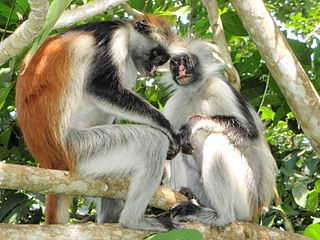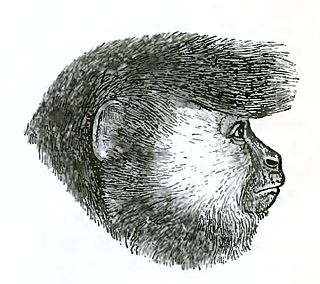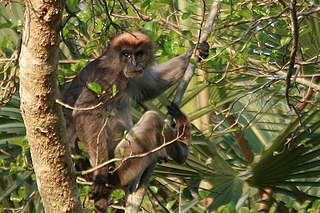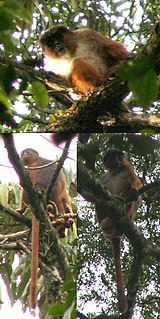
The Colobinae or leaf-eating monkeys are a subfamily of the Old World monkey family that includes 61 species in 11 genera, including the black-and-white colobus, the large-nosed proboscis monkey, and the gray langurs. Some classifications split the colobine monkeys into two tribes, while others split them into three groups. Both classifications put the three African genera Colobus, Piliocolobus, and Procolobus in one group; these genera are distinct in that they have stub thumbs. The various Asian genera are placed into another one or two groups. Analysis of mtDNA confirms the Asian species form two distinct groups, one of langurs and the other of the "odd-nosed" species, but are inconsistent as to the relationships of the gray langurs; some studies suggest that the gray langurs are not closely related to either of these groups, while others place them firmly within the langur group.

Red colobuses are Old World monkeys of the genus Piliocolobus. It was formerly considered a subgenus within the genus Procolobus, which is now restricted to the olive colobus. They are closely related to the black-and-white colobus monkeys, and some species are often found in groups with the blue monkey. The western red colobus is frequently hunted by the common chimpanzee.

Miss Waldron's red colobus is a species of the red colobus native to West Africa. It had previously been described as a subspecies of the western red colobus, P. badius. It has not been officially sighted since 1978 and was considered extinct in 2000. However, new evidence suggests that a very small number of these monkeys may be living in the southeast corner of Côte d'Ivoire. The IUCN Red List notes Miss Waldron's red colobus as critically endangered.

The western red colobus, also known as the bay red colobus, rust red colobus or Upper Guinea red colobus, is a species of Old World monkey in West African forests from Senegal to Ghana. All other species of red colobuses have formerly been considered subspecies of P. badius. It is often hunted by the common chimpanzee. In 1994, western red colobus monkeys infected many chimpanzees with Ebola virus when the chimpanzees hunted the monkeys as prey.

The black colobus, or satanic black colobus, is a species of Old World monkey belonging to the genus Colobus. The species is found in a small area of western central Africa. Black colobuses are large, completely covered with black fur, and like all other Colobus monkeys, do not have a thumb. The species has faced large declines in population due to habitat destruction and hunting by humans, and was consequently listed as Vulnerable on the IUCN Red List in 1994.

The ursine colobus, also known as the white-thighed colobus, Geoffroy's black-and-white colobus, or the white-thighed black-and-white colobus, is a species of primate in the family Cercopithecidae.

The Udzungwa red colobus, also known as the Uzungwa red colobus or Iringa red colobus, is a species of primate in the family Cercopithecidae. It is endemic to riverine and montane forest in the Udzungwa Mountains in Tanzania. It is threatened by habitat loss.

Pennant's colobus or Pennant's red colobus is a species of tree-dwelling primate in the family Cercopithecidae. It is endemic to tropical Central Africa. Three subspecies have traditionally been recognised but its distribution is peculiarly disjunct and has been considered a biogeographical puzzle, with one population on the island of Bioko, a second in the Niger River Delta in southern Nigeria, and a third in east-central Republic of Congo. It is found in rainforests and marshy forests. It is threatened by habitat loss and hunting for bushmeat.

The Tana River red colobus, also called the eastern red colobus, is a highly endangered species of primate in the family Cercopithecidae. It is endemic to a narrow zone of gallery forest near the Tana River in southeastern Kenya.

Preuss's red colobus is a red colobus primate species endemic to the Cross-Sanaga Rivers ecoregion. An important population occurs in Korup National Park, Southwest Province, Cameroon, but the species' distribution is localized. The species is considered present in adjacent Cross River National Park - Oban Division in Nigeria and hunter reports suggest that few groups remain in Nkwende Hills and Nta Ali Forest Reserve in the broader Korup region. A population is also present in Ebo forest, Littoral Province of Cameroon.

Central African red colobus is the traditional name for several species of red colobus monkey that had formerly been considered a single species, Piliocolobus foai. Central African red colobus monkeys are found in humid forests in the Democratic Republic of the Congo, the Republic of the Congo, the Central African Republic and South Sudan.

Thollon's red colobus, also known as the Tshuapa red colobus, is a species of red colobus monkey from the Democratic Republic of the Congo and lower Republic of the Congo. It is found south of Congo River and west of Lomami River. It had once been considered a subspecies of the P. badius. It was recognised as a distinct species by Dandelot in 1974, and this was followed by Groves in 2001, while others have suggested it should be considered a subspecies of P. rufomitratus.

The Ugandan red colobus or ashy red colobus is an endangered species of red colobus monkey, recognised as a distinct species since 2001. There is disagreement however over taxonomy with many considering the Ugandan red colobus to be a subspecies. The Ugandan red colobus is an Old World monkey which is found in 5 different locations across Uganda and Tanzania.

The Niger Delta red colobus is a critically endangered species of colobus monkey endemic to the western part of the Niger Delta. It is threatened by hunting and habitat loss.

Bouvier's red colobus is a species of colobus monkey rediscovered in the Republic of the Congo in 2015, after four decades without a confirmed sighting.

Foa's red colobus or the Central African red colobus, is a species of red colobus monkey found in the Democratic Republic of the Congo.

The Semliki red colobus is a type of red colobus monkey from central Africa. Historically it has been treated as a subspecies of the Central African red colobus but more recent taxonomies generally treat it as a separate species.

Lang's red colobus is a species of red colobus monkey. Historically it had been treated as a subspecies of the Central African red colobus, but more recent taxonomies generally treat it as a separate species.

Oustalet's red colobus is a species of red colobus monkey. It lives in various types of forest in southern South Sudan, southern Central African Republic, northern Democratic Republic of the Congo and northeastern Republic of the Congo. It eats leaves, fruit, flowers, buds and possibly seeds. Males have a head and body length of between 45.9 and 68 cm with a tail length of between 55.5 and 73 cm. Females have a head and body length of between 52 and 64 cm with a tail length of between 68 and 73 cm. Males weigh about 12.5 kg (28 lb) and females weigh about 8.2 kg (18 lb).

The Lomami red colobus is a type of red colobus monkey from central Africa. Historically it had been treated as a subspecies of the Central African red colobus, but more recent taxonomies generally treat it as a separate species.



















